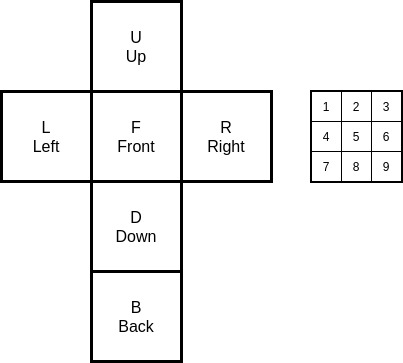Something to keep me entertained through the final throes of lockdown #3 in the UK.
The plan:
- In JS: work out a sensible way of modelling a Rubik's cube, and the available moves. Make sure it is easily interpretable (maybe some 90s style ASCII art output for MVP?)
- Work out the best way to solve this. Using an MDP? Q-learning? Something else?
- Do we need to build in some tacit knowledge, e.g. strategies at each stage? Or - better - can we let the algorithm learn with no prior knowledge?
- Build a simple web interface to show the magic happening.
- Bonus points: use WebGL to show it in 3D (this would be a good starting point).
Define six faces: F (front), B (back), L (left), R (right), D (down), U (up).
Squares on a side are numbered 1-9, starting from top-left.
This gives us a notation to work with, e.g. `R.6' would be the right-middle square on the right hand side.
As per above, each face has nine squares defined, numbered 0-8. Rotations on that face are easy:
- 0 -> 2
- 1 -> 5
- 2 -> 8
- 3 -> 1
- 4 -> 4 (no change)
- 5 -> 7
- 6 -> 0
- 7 -> 3
- 8 -> 6
It is a bit harder for the rows on the other four sides. I think each face will need to be explicitly linked to the other four faces, and the rows. This will need to be directed (say, CW).
Keep everything zero-indexed for simplicity.
For example: the links for F (front) would be:
[
// order matters, but the starting point doesn't
{
face: 'U', // or some enum representation
squares: [6, 7, 8]
},
{
face: 'R',
squares: [0, 3, 6]
},
{
face: 'D',
squares: [0, 1, 2]
},
{
face: 'L',
squares: [2, 5, 8]
},
]Working out the numbers gets a bit confusing. The rule needs to be 'if you rotated the face in your direction'.
Same as https://github.com/pidg3/node-template
npm run dev: watches TS files for changes (make sure in /src), rebuilds and runs Node again.npm run prettier-format: run prettier and fix, default config except tabs = 2 spaces, single quotes.npm run lint: run ESLint with default config.- Pre-commit hook setup to check prettier and linting, but without changing anything.
